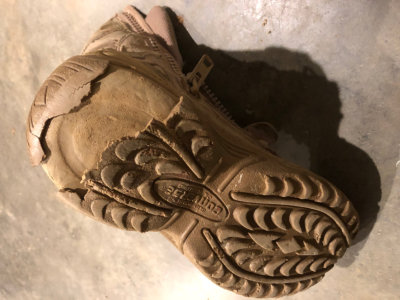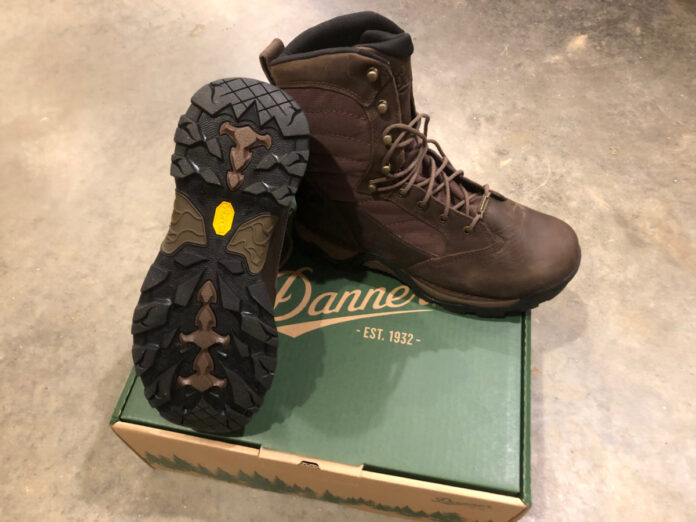We went to the town Wednesday. Because it’s close to an hour one way, we usually make a day of it and run all our errands at once. Yesterday was no exception.
The highlight of my day was buying a pair of Danner boots with Vibram soles, as pictured above. I wish the boots were waterproof, but otherwise I am very happy with them. I tried on four pairs of boots from three different brands, and these were the best fit by far. I’ll wear these walking, hiking our mountain, and about the homestead when I am doing tasks that don’t require a safety toe or a muck boot. But first, I’ll wear them around the house for a couple weeks to break them in.

The new boots replace my old combat boots that finally fell apart. (I wore them during my painting activities and my wife laughed when she saw the terrible shape they were in, but there is no use getting paint splatter on a decent pair of boots.)
I think the adhesive bonding the midsole and outer sole just reached the end of its useful life and lost adhesion, causing them bottom to peel off. It’s a shame because they were comfortable right until the end and the uppers held up, even though they were dirty. The old boots are at least nine years old, so they don’t owe me a thing.
Danner is a good American brand that makes outdoor boots for loggers and hunters. I’ve had a pair before and they were very rugged. Unfortunately, these were made in Vietnam, but in my mind, that’s still better than China.
Think of Footwear as Shelter for Your Feet
If you have ever injured your foot, had plantar fasciitis, bunions, corns, or even an ingrown toe nail, you know how limited your movement and how ineffective you can be in a physical task if you have sore or painful feet. No wonder they excused people with flat feet from military service for much of the 20th century.
I have learned the hard way that wearing safety toe boots is a good idea when working around heavy equipment or heavy objects. The older I get, the more important taking care of my feet has become. Today, I have a range of shoes and boots, and I pick the one best suited for each day’s use.
If you are one of those folks who believe they can wear a light pair of sneakers all their life, let me disabuse you of that notion. Sure, they may be comfortable to stand around in or even to run in, but try spending all day on a ladder and you will find you need a shoe with a stiffer sole. Try climbing a steep, rocky trail and you will find that you need the ankle protection offered by a taller pair of boots. Go hunting on a snowy November morning and you’ll wish they had 600 grams of Thinsulate insulation and a waterproof liner. Try mucking out an animal pen and you’ll find your shoes get sucked off by the mud and manure, leaving you hopping awkwardly and lamenting the loss of your shoe. Sneakers aren’t for preppers unless you wear them when you run away from a threat.
Preppers Need Good Boots
I am convinced that all preppers (except possibly someone preparing to spend their lives in a sealed bunker) need at least a couple pairs of boots. Your prepper boots should be broken in, sturdy, comfortable, and tough. You should be able to stand for hours and wear them for days without developing hot spots or blisters.
You need multiple boots for two reasons: One, you will probably do different tasks in different seasons; and two, your boots will last longer if you rest them between wearings to give them a chance to dry out. Many distance hikers will change out of their hiking boots as soon as they make camp. I take my boots off when I head inside, and you can often find a pile of our boots in the garage where we have a bench to sit while we put them on.
I’m not against shoes, I just don’ think they are as important as boots. For example, I have sneakers I can slip into if I am barefoot and the driveway alarm goes off or there is a bump in the night. But I will not be bugging out in them unless something has gone terribly wrong.
Boot Buying Tips
When it comes to buying footwear, don’t skimp. Saving money while sacrificing quality is going to bite you in the big toe (and probably in your arch and your heel, as well). Buy the best you can afford. This means don’t buy your boots at box stores unless you have no choice.
I like combat boots because they are rugged and will last years, as my Converse boots did. If I lived in a cold, snowy location, I would buy the military surplus Mickey Mouse boots. I have a pair of Marine-issue RAT boots that I often wear when working on carpentry projects. Their soles are sewn on, and when they finally wear out, I can replace the outer sole. Hopefully, this will be done by a professional, but if it is after the SHTF and I have to cut out a chuck of tire tread, trim it to fit, and sew them on with thread made from deer sinew, then by gosh and by golly, that’s what I’ll do. It will bet going barefoot.
Many companies like Altama and Bates that make or have made combat boots also make similar “tactical” boots (which is what my worn out Converse really were). While not issued, these can still be good boots. These same companies will also make work boots, which are also good options for tasks around the homestead. Companies like Danner and Redwing boots have multiple lines of boots, from work to outdoor to hiking. I know little about pure hiking boots, but I would not count on a lightweight trail runner to carry you far in a disaster situation. If you buy hikers, go with a pair designed for the long haul with a heavy pack. Your feet and your back will thank you.
Get a Good Fit
Fit is important, but it is also highly personal. Unless I am buying the exact duplicate of a boot I already own, I like to try them on rather than buy online. I like them a little loose so I can wear a thicker sock in the winter, but they must be able to be cinched down tightly with a pull of the laces. You don’t want your foot to slide around or your heel to go up and down insider your boot. You want your foot and boot to move and flex as one.
Tough boots can take time to break in, especially if you have never worn them before or if they are a different height than you are used to. Start wearing them around the house for an hour or two at a time. Then wear them on brief excursions. Wearing a stiff, new boot on a long work shift is asking for trouble.
Don’t Forget the Socks
Socks are important too. I like a crew sock that will stick up above the boot. Although many military socks will go up to your knee, these are too high for my preference unless I am wearing tall farm or muck boots. Wool is my favorite sock material, and I wear wool socks for eight or nine months a year. Many socks will say “wool” but examine the package and you will find that they are wool blend. Up to 10 or 15 percent nylon or another synthetic material added to the wool to add strength is fine, but don’t get a sock that is 18 or 32 percent wool and loaded with acrylic, polyester and other man-made fibers and think you are wearing wool socks.
Surprisingly, some of the best socks I have ever owned were purchased at Costco for far less than Wigwam or other name brand socks.
If your boots are bothering you and you fear you may be developing a blister, put on a thin sock liner and your normal sock under it. That may help. Professionals will urge you to carry moleskin and apply it, but I have found a fabric Band-Aid or even a piece of medical tape from your first aid kit will help prevent a blister if caught early enough.







